The most recent report (report 93, April 22th) published by the World Health Organization indicates that almost 2.5 Millions of people have been globally confirmed as COVID-19 cases (https://www.who.int/emergencies/diseases/novel-coronavirus-2019/situation-reports).
With respect to my previous update (April 16th, https://www.emigrantrailer.com/2020/04/17/corona-virus-covid-19-latest-update-from-the-world-16-april-2020/), I decided to separate the nations with the highest number of cases into two categories: those which exceed 100000 cases (see Figure 1) and those which exceed 20000 cases (see Figure 2).
Figure 1: Nations above 100.000 cases
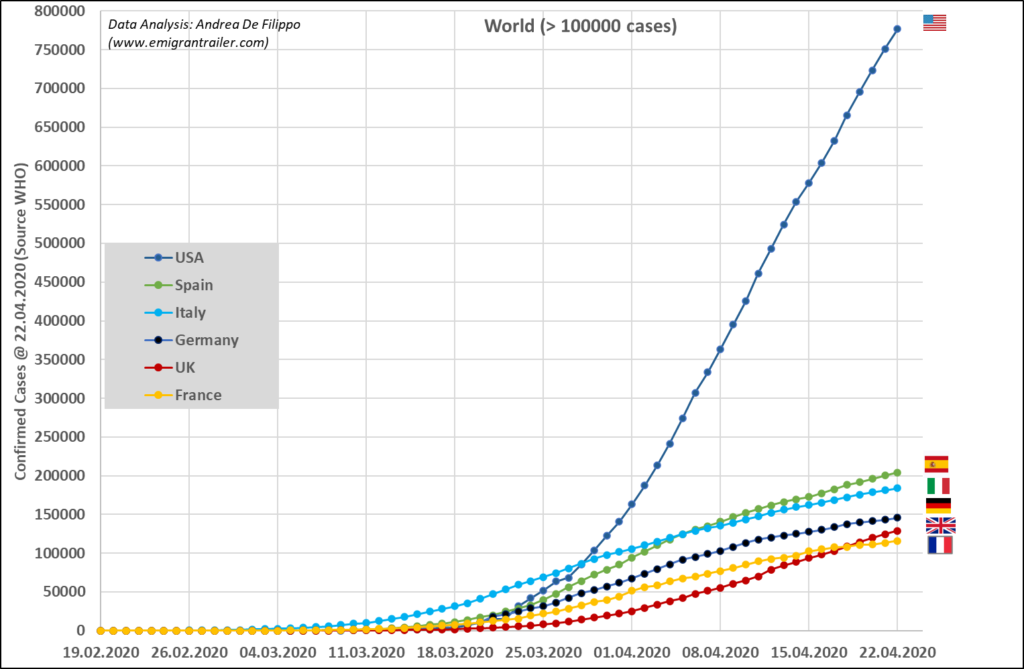
With an average of almost 30000 cases/day, the United States of America (USA) continued the negative trend and they are going to overpass 800000 cases in these hours. During last week, the United Kingdom (UK) passed the 100000 thresholds, in addition to the total number of cases registered in France. Among the European nations in Figure 1, UK had the worst trend with about 5000 cases/day.
Compared to the previous week, the number of cases/day remained basically unchanged in Spain (about 4400 cases/day), while it decreased in Italy (about 3100 cases/day) and Germany (2500 cases/day). France had a significant decrease, moving from about 3400 cases/day to 1800 cases/day during last week.
Figure 2: Nations above 20.000 cases
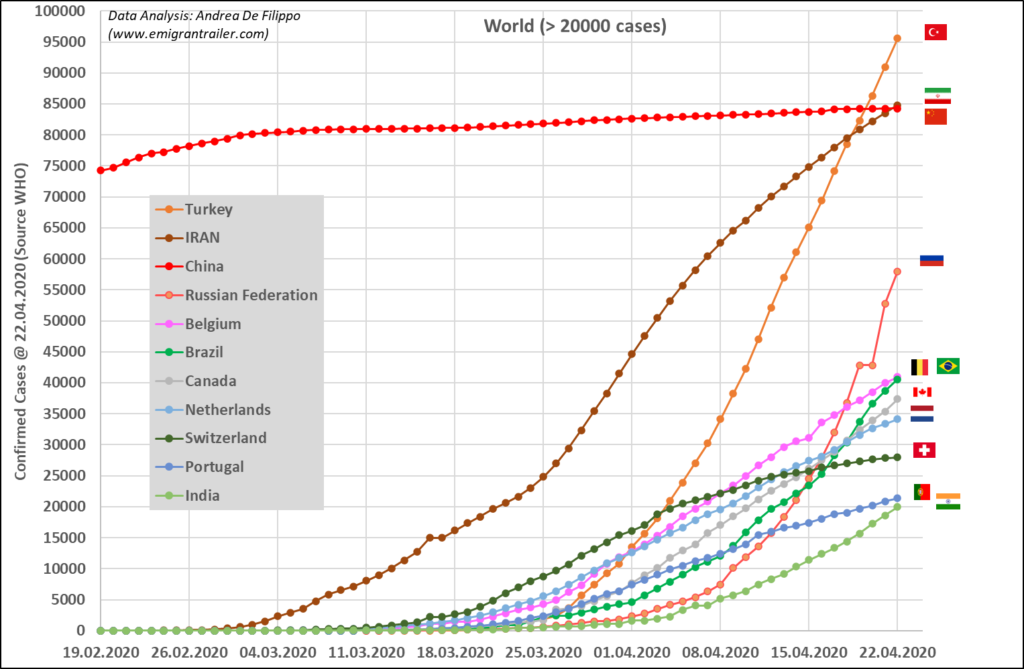
Turkey is not far from 100000 cases and had a similar average number of cases compared to UK. Similar negative trend is showed by the Russian Federation. Despite its high number, the Republic of Iran seems to be on the track to flatten the curve with about 1400 cases/day. This situation is instead reached by both China and Switzerland, both somehow stable in the last few days respectively around 84000 cases and 28000 cases.
Brazil reached 40000 cases in total, with a negative trend of 2500 cases/day. The gap is now minimal with Belgium; the latter luckily had a positive reduction of cases/day in the last week: from 1400 to 1200 cases/day. The situation in Netherlands is unchanged (about 1000 cases/day) and now Canada shows a higher number of cases.
New entries of the week are Portugal and India. The latter is not yet at the indicated threshold but it is very close (19984 total cases). Moreover, the rate of increase is much higher for India than Portugal: 1200 cases/day vs 500 cases/day.
The negative consequences of COVID-19 are also displayed in the following two charts, with nations above 10000 deaths (Figure 3) and nations above 2000 deaths (Figure 4).
Figure 3: Nations above 10.000 deaths
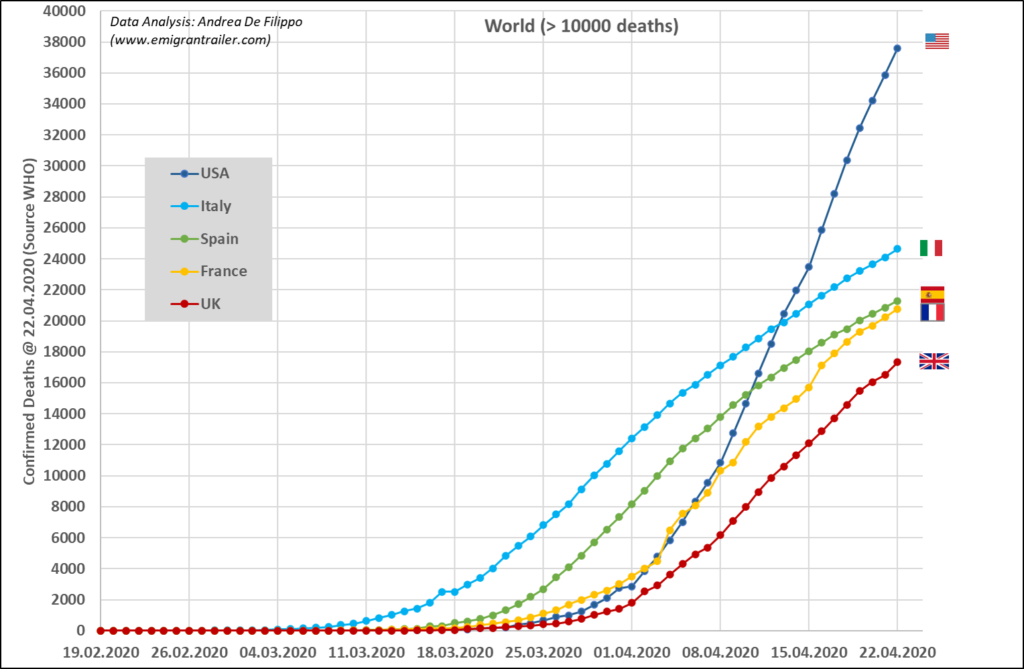
The situation in the United States of America (USA) remains extremely critical and dramatic, with about 2000 deaths/day. The situation slightly improved for Italy and Spain, which had respectively an average of 500 and 450 deaths/day. However, this number is still too high. France and UK had a worser situation compared to Italy and Spain with about 600 and 800 deaths/day. France reached more than 20000 deaths and it is expected to overcome Spain in the next days.
Figure 4: Nations above 2.000 deaths
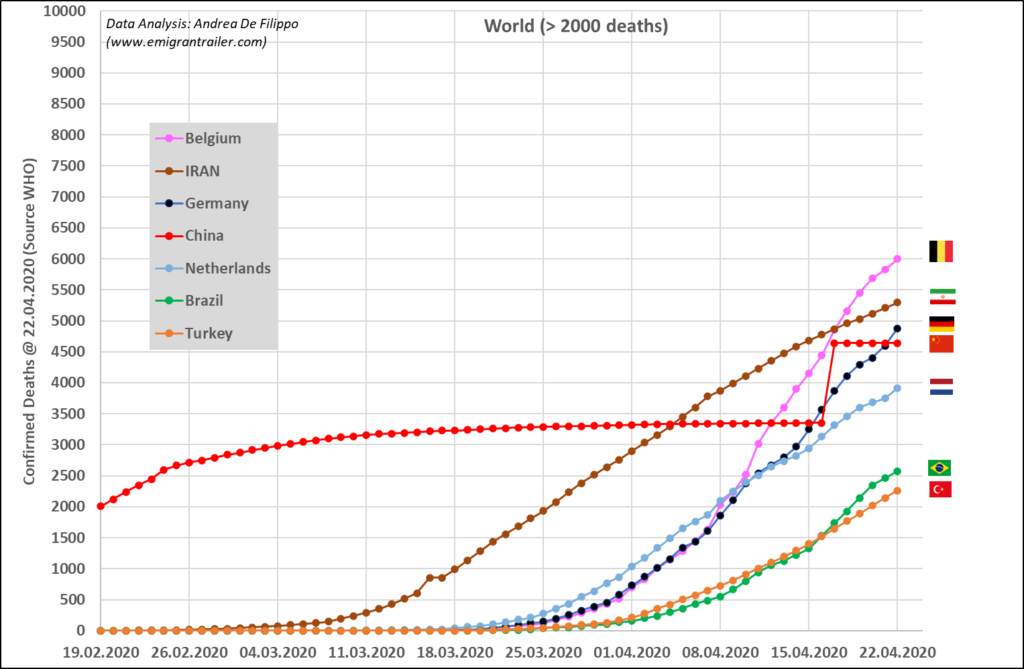
During the last week the situation improved in Belgium, with a decrease from 315 deaths/day to 260 deaths/day. However, this value doubles basically the one in the neighboring nation, the Netherlands, that showed 130 deaths/day. Germany has a constant increase, slightly above 200 deaths/day, not different from previous week. Significant improvement is documented in Iran, which is now below 90 deaths/day. Both Turkey and Brazil reached more than 2000 deaths during the last days and showed a similar trendline.
Few words about the trend of China with an unexpected step increase as of April 17th. As documented by WHO, the Chinese authorities informed that “Information from a variety of sources was reviewed, leading to duplicate cases being removed and missed cases added. Following this review, the total number of cases in Wuhan increased by 325 and the total number of deaths increased by 1290” (https://www.who.int/docs/default-source/coronaviruse/situation-reports/20200417-sitrep-88-covid-191b6cccd94f8b4f219377bff55719a6ed.pdf?sfvrsn=ebe78315_6).
The next part of the analysis focuses on specific cases in different geographical areas.
Figure 5 & Figure 6: the situation for other European countries
These are the nations with cases below 20000 (Figure 5) and deaths below 2000 (Figure 6).
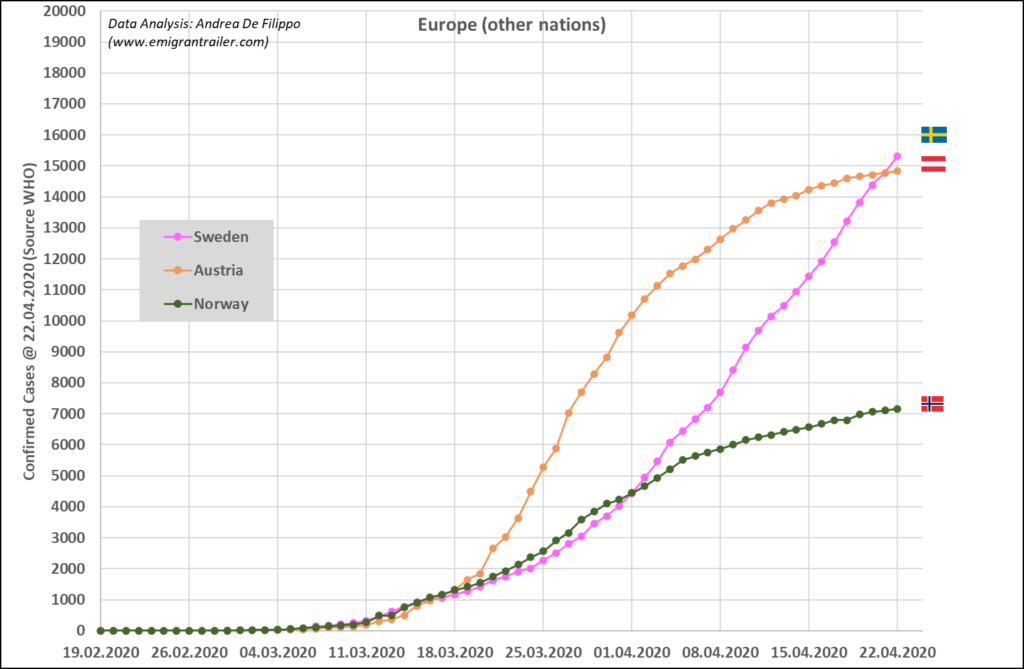
During last week, Sweden reached more than 15000 cases (with an average of about 560 cases/day) and simultaneously more than 1700 deaths (with an average of about 90 deaths/day). The situation is completely different for the neighboring Norway, which has “only” 7166 total cases (with an average of about 80 cases/day) and 10% of the deaths in Sweden: 163 (with an average of 5 deaths/day). Both charts in Figure 5 and Figure 6 show basically flattened curves for Norway.
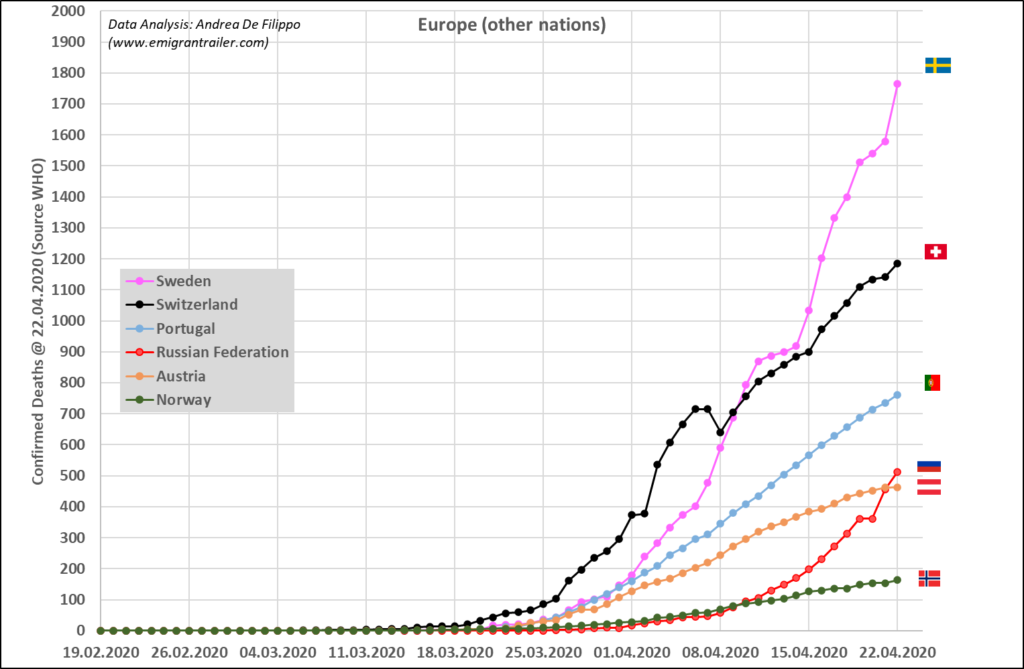
The same flattened curve seems to characterize the situation in Austria, with an average of about 80 cases/day (Figure 5) and about 10 deaths/day (Figure 6).
Figure 6 also reports the status of deaths for some nations with high number of cases (>20000): Switzerland, Portugal and the Russian Federation. For all of them, the tendency of last week is similar with lower than 50 deaths/day, respectively 35 in Switzerland, 27 in Portugal and 47 in the Russian Federation.
Figure 7 & Figure 8: the situation for other Asian and Oceanian countries
These are the nations with cases below 20000 (Figure 7) and deaths below 2000 (Figure 8).
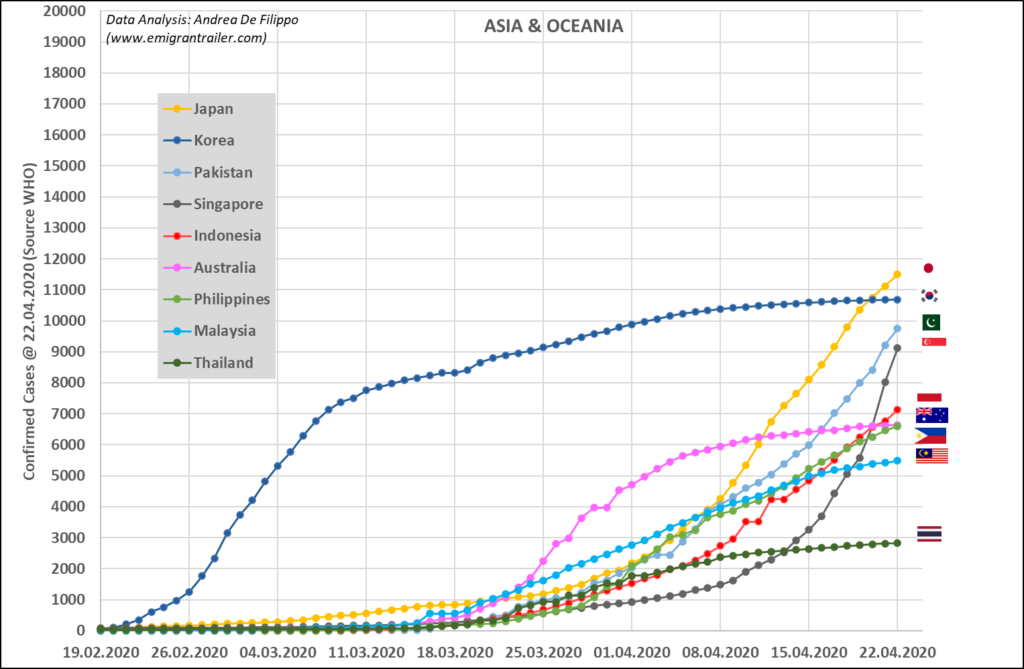
In general, the evolution during last week confirms that there are several countries which show a tendency to flatten the curve for the documented cases & deaths: South Korea (with an average of about 13 cases/day and 9 total deaths in the last week), Australia (with an average of about 30 cases/day and 2 deaths/day), Malaysia (with an average of about 70 cases/day and 9 total deaths in the last week) and Thailand (with an average of about 26 cases/day and “only” 3 deaths in the last week).
Singapore remains a “special” situation. In fact, it is one of the nations with COVID-19 cases since January and with a tendency to increase the cases day by day (last week worsened with an average of > 904 cases/day), but with a very low amount of deaths (11 in absolute) (Figure 8).
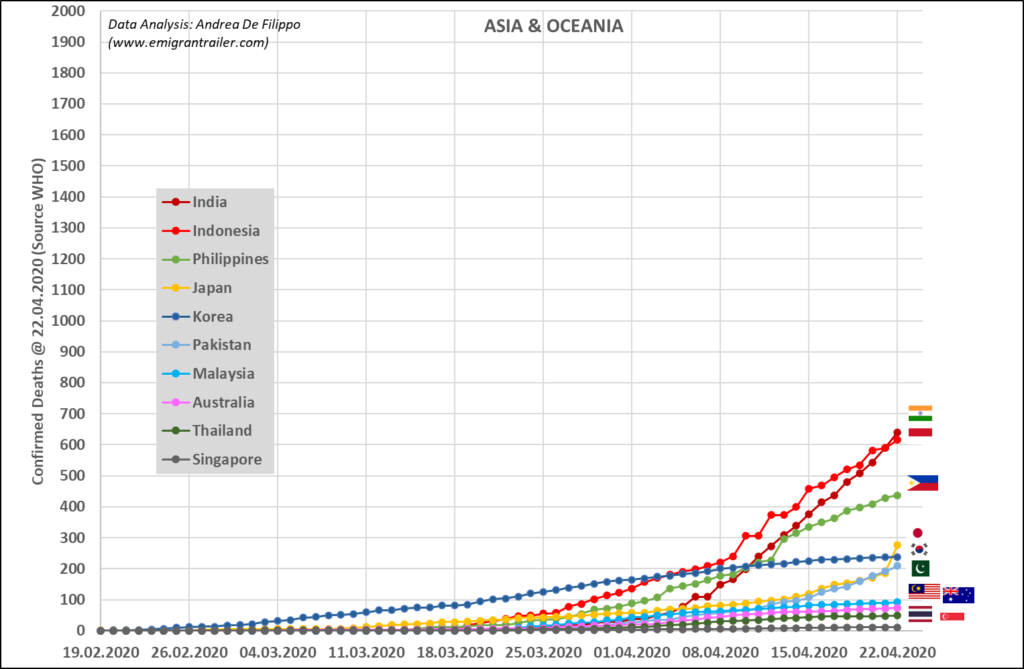
India has worsened its situation in the last two weeks, becoming the third country in Asia (after China & Republic of Iran) for number of cases (almost 20000, see Figure 2). The negative trend is also very visible when we look at the deaths in Figure 8: in terms of absolute values is still low (below 650) compared to its population, but the average deaths/day is increasing.
This week, Indonesia reached 7000 cases (Figure 7) and more than 600 deaths (Figure 8). The increasing trend seems to be unchanged compared to previous week. A similar scenario is present in Pakistan, with an average of about 540 cases/day and 15 deaths/day. Instead, there was a marginal improvement in the Philippines with a reduction of case/day (191 vs 226) and deaths/day (14 vs 23) compared to last week.
Finally, Japan is constantly around 500 cases/day but it showed a sudden increase of deaths as of 22 April 2020. According to WHO, the latter could be explained by the fact that “Japan changed the method of reporting deaths, which now includes both the number of deceased cases with complete data matching and verification; and deceased cases whose data matching and verification are in progress”.
Figure 9 and Figure 10: American and African countries
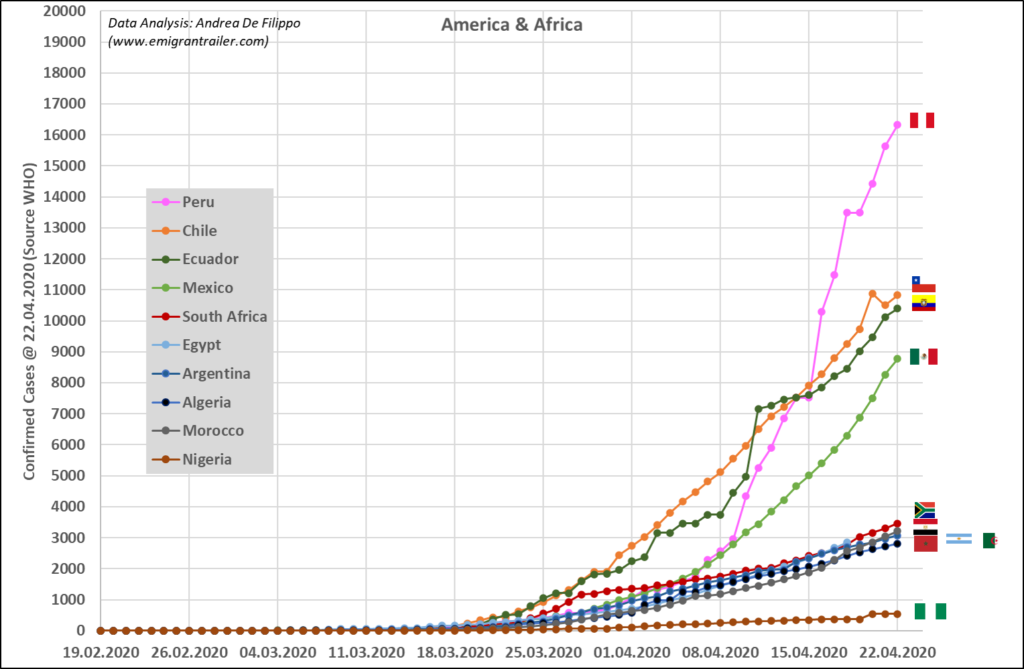
Peru had a significant increase of cases/day: more than 1000 in the last week. Luckily, it did not correspond a similar increase of death/day, which is about 35. But, of course, we need to wait few weeks to observe possible negative effect of such large increase of cases.
Chile & Ecuador had a similar trend (about 420 cases/day) but Ecuador documented more deaths (132 vs 53). Compared to previous week, Mexico also worsens for both cases/day (560 vs 360) and deaths/day (51 vs 38). During last week, South Africa, Morocco, Argentina, Algeria and Egypt reached similar amount of cases, between 2800 and 3500. However, the effect on the documented deaths is different in the last 6 days, with 81 total deaths in Egypt and 51 total death in Algeria, while the other nations where below 40 deaths (see Figure 10).
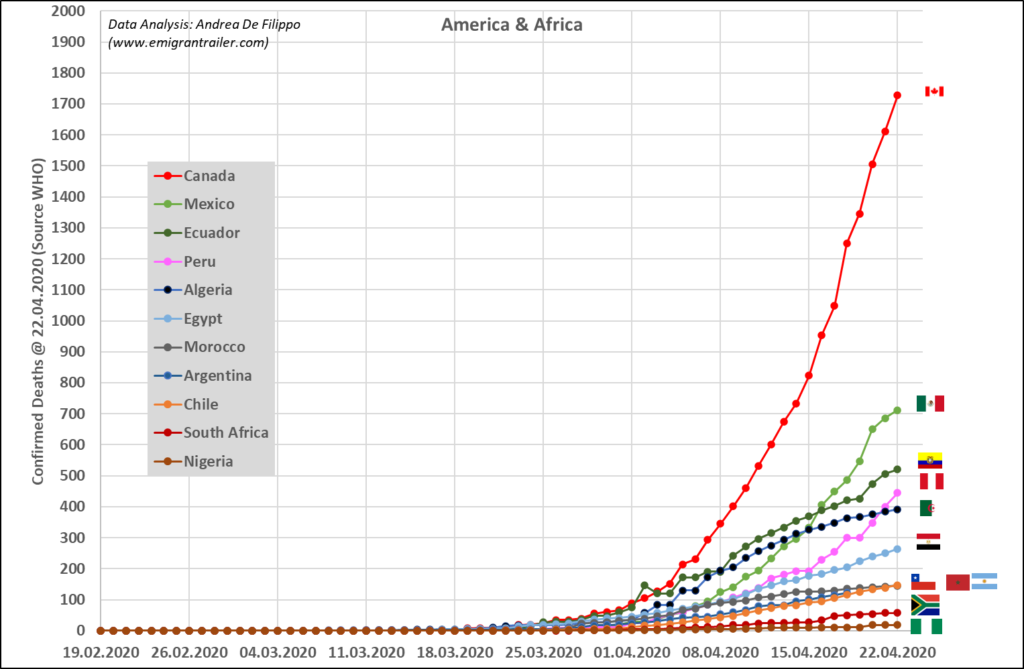
There were few updates for Nigeria, that still confirms very few cases and deaths compared to its population.
Finally, as showed in Figure 10, Canada is still below 2000 deaths. However, the trendline is not very positive with about 130 deaths/day.
Conclusions
In summary, there are not yet significant signs of improvement in the United States of America, and with due proportions, Canada and Mexico follow the trend of their neighbor nation. In addition to Brazil, there are other alarming situations in most of northern regions of South America: the possible negative consequences (deaths) could become true in the next days. On the other side of the Atlantic Ocean, most of European nations continue to have daily increase for cases and deaths (still much greater than 100 deaths/days) and only few of them seems to have concretely slowed down (Austria and Norway among those in this review). Positive signals arrive from African and Oceanian countries, which are still “under control”. Asian countries are divided among those with a stable and flattened situation (China, South Korea, Malaysia, Thailand) and those with increasing trends at least for cases/day (Japan, Singapore, Pakistan, India and Indonesia).
Other info and analysis about Covid-19 at link: COVID-19 (Corona Virus) | EmigranTrailer.
Stay healthy!
Andrea De Filippo
_______________________________________________________________________________
Please find below the link to each Figure presented in post:



